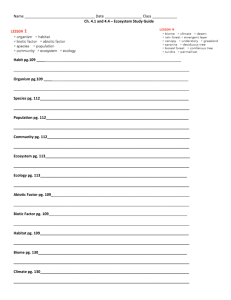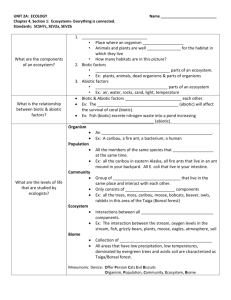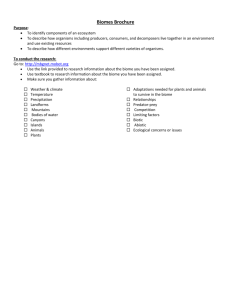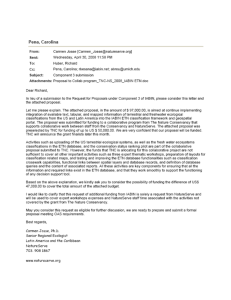Achievement Scale Content Area: Biology Grade Level: 10 Unit
advertisement
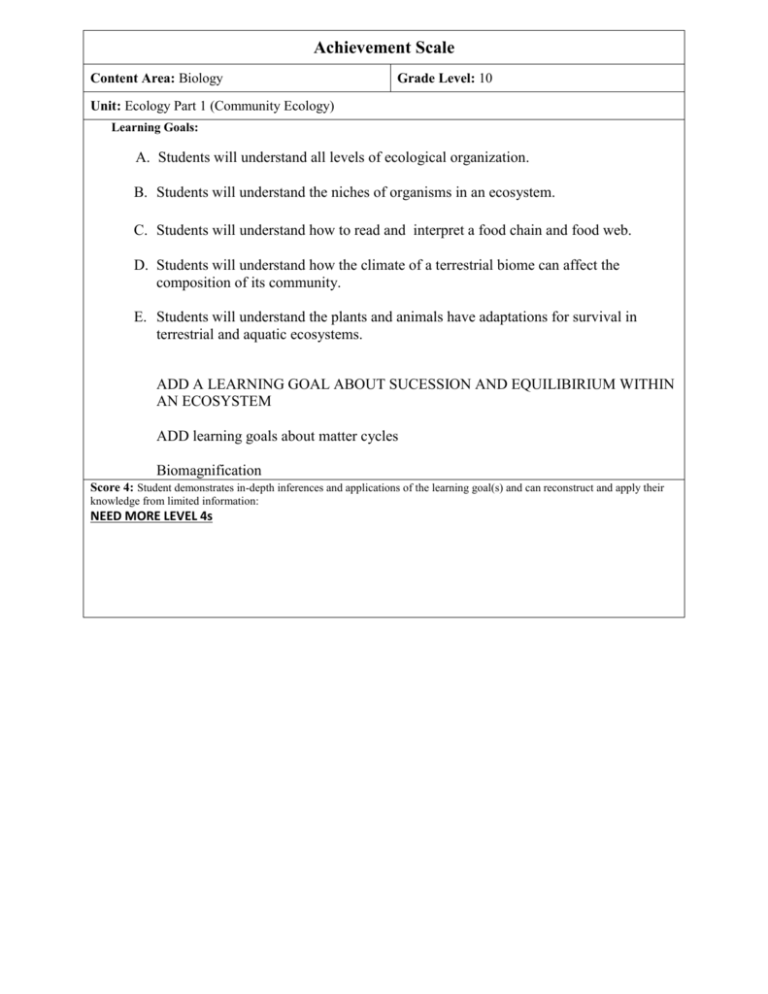
Achievement Scale Content Area: Biology Grade Level: 10 Unit: Ecology Part 1 (Community Ecology) Learning Goals: A. Students will understand all levels of ecological organization. B. Students will understand the niches of organisms in an ecosystem. C. Students will understand how to read and interpret a food chain and food web. D. Students will understand how the climate of a terrestrial biome can affect the composition of its community. E. Students will understand the plants and animals have adaptations for survival in terrestrial and aquatic ecosystems. ADD A LEARNING GOAL ABOUT SUCESSION AND EQUILIBIRIUM WITHIN AN ECOSYSTEM ADD learning goals about matter cycles Biomagnification Score 4: Student demonstrates in-depth inferences and applications of the learning goal(s) and can reconstruct and apply their knowledge from limited information: NEED MORE LEVEL 4s Score 3: Student demonstrates no major errors or omissions regarding the learning goal(s) that were explicitly taught: A3. Students will be able to describe all levels of ecological organization in order from smallest to largest with descriptions of the biotic and/or abiotic parts of each level. B3. Students will be able to compare and contrast the different roles of organisms in an ecosystem by producing examples of each and describing how they obtain energy. C3. Students will be able to predict how a change in a species’ population will impact the ecosystem. D3. Students will be able to describe and compare the characteristics of the major terrestrial biomes. E3. Students will be able to compare and contrast the anatomical and physiological adaptations of different organisms. Score 2: The student demonstrates no major errors or omissions regarding the simpler details and processes that support the learning goal(s). A2. Students will be able to list the 6 of the levels of organization in order from smallest to largest. B2. Students will be able to identify if an organism is a producer, carnivore, herbivore, omnivore, and decomposer. B2. Students will be able to identify species relationships as mutualism, commensalism, parasitism, competition, or predation. C2. Students will be able to label trophic levels in a food chain, food web, and a ecological pyramid. D2. Students will be able to identify the abiotic and biotic factors that characterize a biome. E2. Students will be able to identify anatomical adaptations of different organisms. Score 1: With help (being given word banks, manipulated equations, retakes), the student demonstrates a partial understanding of the simpler details and processes that support the learning goal(s). Score 0: Even with help, no success. Score 4 Example Assessment Items: Score 3 Example Assessment Items: Score 2 Example Assessment Items: Academic Vocabulary: biosphere species population community ecology ecosystem biome biotic factor abiotic factor autotroph/producer photosynthesis chemosynthesis heterotrophy consumer carnivore herbivore scavenger omnivore decomposer detrivore trophic level food chain phytoplankton zooplankton food web ecological pyramid biomass climate micro climate greenhouse effect habitat niche competitive exclusion predation keystone species symbiosis mutualism parasitism commensalism ecological succession primary succession pioneer species secondary succession terrestrial biome aquatic biome photic zone aphotic zone benthic zone (benthos)

